Jack was ordered to return to his unit by his section sergeant, Oscar Hookway, but he refused. As he said to a New Zealand stretcher-bearer, Pte. James Gardner Jackson (who had followed Jack’s example and was using a donkey to carry the wounded - though only for five days) - “To hell with them. The old donk and I can do as much work as four men” (two stretcher squads). Jack could only feed his donkeys by tying them up next to the mules of an Indian artillery unit, at the end of each day. He camped and ate with the Indians of the 21st Kohat Mountain Battery at the foot of Shrapnel Gully. These Sikh gunners, who have a proud military tradition of their own, admired Jack enormously. They called him “Bahadur”, which means the Bravest of the Brave. For three days, however, Jack was technically a deserter from his unit, the most serious crime in the army in wartime.

Sgt. (later Warrant Officer) Oscar Roy Hookway MID (Courtesy of George Hookway).
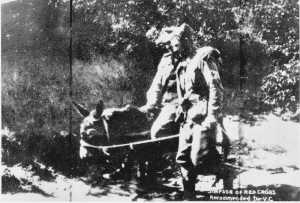
This is the only authentic photograph of Jack and Duffy in action, in Shrapnel Gully. It was clearly taken during the first days at ANZAC as Jack is still using his first field dressing ‘lead rope’. Note the gauze dressing over Duffy’s nose; also the forage cap worn sideways on the head of this larrikin, and the grin on the face of his passenger at the entertainment provided by this donkey-man (Australian War Memorial A03114).
Jack had a number of donkeys, and passengers killed, by enemy fire, right next to him as he made his perilous donkey-trips down the “Valley of Death.” He replaced each donkey as it was killed, but he only ever used one donkey at a time. Apart from the testimony of his friends and officers of 3 Field Ambulance, of James Jackson, and the two officers at the Indian artillery unit, one look at the photo of Jack and Duffy in Shrapnel Gully shows why this was the case. Every statue or painting of the Man with the Donkey shows Jack’s passenger holding on to him for support, which is how it could only have been. Jack’s passengers were wounded men, in a weakened disoriented state. It would have been the greatest test of stamina for the fittest man to have remained aboard a donkey, entirely by his own efforts, for a one kilometre ride - even on the flattest, most even of surfaces - without any reins, saddle, stirrups or anything else to hang on to. And that overgrown, broken downhill track, to the accompaniment of constant explosions and gunfire was no stroll along the sands. The idea of a second donkey following along behind, unescorted or led, with a wounded soldier aboard fending totally for himself, (as has been suggested by one source) simply cannot be accepted.
But the most conclusive evidence is again provided in the photo, where in Jack’s left hand we see him carrying a cane switch - that essential for all experienced donkey-men. Donkeys are notoriously stubborn little creatures. Unlike a pony they will not happily plod alongside or behind their masters. They sometimes dig in their heels and refuse to move - for no apparent reason. Then they need to be coaxed, or prodded, or forced along. Pte. F.W. Dyke was an eye-witness to one example of this at Anzac. “A padre was standing by waiting to accompany Simpson, but with all his coaxing the donkey wouldn’t move. At last Simpson turned to the padre and said, “Padre, this old donkey has been tied up with some mules and has acquired some of their mulish habits. Would you move along the beach a little way, as I’ll have to speak to him in Hindustani, and Padre, I wouldn’t like you to think I was swearing at him.”
On the morning of Wednesday, April 28th Capt. McWhae was wounded in the forehead and eye by shrapnel, and was evacuated to the transport ship Galeka, where surgeon, Major Harry Butler removed his eye. Capt. Lyle Buchanan took over C Bearer Section with Capt. Victor Conrick, who had been ill at the landing, resuming control of A Section. The following day the commanding officer of 3rd Field Ambulance, Lt-Colonel Alfred Sutton eventually managed to get himself and the rest of his unit ashore. One of the first things he was told was of the “deserter” using a donkey instead of a stretcher to carry the wounded. Instead of ordering his immediate court martial (which would have been the case in the British Army) Sutton praised Jack’s initiative. Let him continue, Sutton told his officers, “his was a special case.” Sutton allowed Jack to live away from his unit - the only private at Gallipoli so favoured. The only condition Sutton insisted on was that Jack report back regularly to have his name marked off the unit roll.
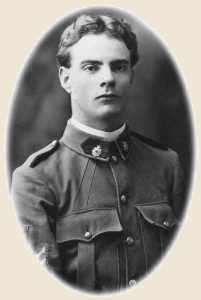
Lt-Col. (later Colonel) Alfred Sutton CB, CMG (Courtesy of Dr. J. Sutton).
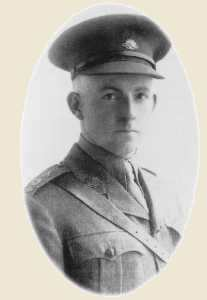
Major (later Colonel) Harry Nairn Butler DSO (Courtesy of John Teniswood).
A few days later Lt-Col. Sutton demonstrated his admiration for Simpson by taking off his Red-Cross armband and tying it around the donkey’s head, telling the assembled men that as the donkey was now a member of the unit he would make it official.
Some time after Jack was killed, Major Harry Butler, the officer commanding Simpson’s section, took Sutton’s armband off Duffy’s head and kept it (it bears Sutton’s signature), carrying it with him throughout the war. After the war it became a treasured Butler family heirloom, until in 1992, Butler’s grandson, John Teniswood, sent Duffy’s Red-Cross headband to the Australian War Memorial, Canberra (where it is now held), believing that it belonged to all of the people of Australia.
Shortly after he became Jack’s Bearer Officer, Capt. Buchanan warned Jack, officially, of “the inevitable result of wounding or worse” if he chose to continue with his donkey trips. Jack chose to continue.
Unlike the other bearers, leading his donkey along Jack was totally exposed almost all of the time to the constant shrapnel, rifle and occasional bursts of machine-gun fire which swept the valley. He was forever being warned by well-meaning soldiers of the suicidal nature of his work. His joking reply was invariably, “My troubles.” Buchanan described sthe situation in Monash Valley thus: “Other people using the valley had a dozen waist-high shelter spots... (Simpson) had really only one spot on the way which sheltered him and his donkey.” Buchanan added that “he had earned (the Victoria Cross) fifty times.”
Jack became a living legend at Anzac as he made his daily donkey-trips. One eye-witness, Major C.H. Brand DSO (later Major General and Chief of the General Staff) later wrote: “Almost every digger knew about him. The question was often asked: “Has the bloke with the donk stopped one yet?” It seemed incredible that anyone could make that trip up and down Monash Valley without being hit. Simpson escaped death so many times that he was completely fatalistic. He seemed to have a charmed life.” Andy Davidson, Distinguished Conduct Medal and Military Medal winner, wrote of Jack that “he was the most respected and admired of all the heroes at Anzac.” Captain C. Longmore, writing in the West Australian, in 1933, in response to the proposal to honour Simpson’s memory with a statue, remembered how the soldiers “watched him spellbound from the trenches... it was one of the most inspiring sights of those early Gallipoli days.”
But if Jack’s work was beyond praise he wasn’t always exactly saintly in his behaviour. Two soldiers in particular felt the rough edge of this donkey-man’s nature, first hand.
Jack had brought an officer down the valley on board Duffy and when they arrived at the beach hospital the officer reached into his pocket and offered Jack a gold sovereign. Jack stood looking at it for a moment then said: “Keep yer bliddy quid. I’m not deein’ this for money”, then he turned on his heel and strode off.
Another soldier felt Jack’s wrath even more forcefully. Jack was bringing an Aussie with a shattered ankle down the valley when he came to the 1st Battalion Aid Post in the bend of Monash Valley. “Come in and have a mug of tea, Murph”, the men called out to him. Jack told them that he had to get his passenger to the beach. “I’ll take him for you”, one of the men offered. Jack agreed and some time later he saw the man coming back, riding Duffy.
Jack was livid. “You stupid lookin’ sod!”, he yelled out - to Private Tom Yeomans - “the only chance the poor little bugger hez of gettin’ a bit of a rest and yee hev to ride him back half a mile up this hill.” Jack could have knocked Yeomans off the donkey’s back, he was so angry (as Yeomans later recalled). “Sorry mate”, Yeomans said, “I didn’t realise.” Jack’s anger disappeared as quickly as it had arisen, a summer storm. “That’s alreet mate”, he grinned, punching the soldier lightly on the shoulder, “Divint dee it again, eh!”
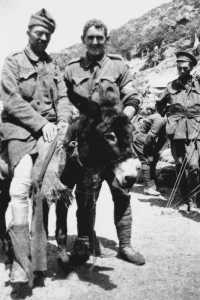
A later photo taken of Jack, near the foot of Shrapnel Gully. Note the sacking ‘saddle’ he has fashioned, and the primitive stirrups. (Australian War Memorial J06392).
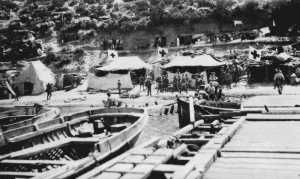
1st Casualty Clearing Station on the beach at Anzac Cove, May 2nd 1915, where Jack delivered his casualties to. Photo by Lyle Buchanan (Courtesy of Mrs Gail Penrose).
Other soldiers, however, spoke of another Simpson entirely. Private P.G. Menhennet described how Jack appeared at Pope’s Hill during the fighting at the Bloody Angle: “It was fierce and many of us were soon out of action and placed out of the line of fire for evacuation... After a terrible night daylight eventually arrived and soon after came Simpson. Some of our cases were pitiful but this cheerful digger had a word and smile for all. He came to me and asked me what was wrong and I told him I’d been shot through the right leg above the knee... He rebandaged my leg and helped me to his famous donkey. Two or three times on the way he grinned at me and said, ‘That was a very nasty spot we have just passed. Jacko’s snipers are wonderful shots. It doesn’t do to linger in such spots’. When you realise that he knew the extreme dangers to which he so constantly exposed himself in his self-imposed errands of mercy you can only marvel at the cheerful way in which he carried out his duties. He brought me safely back to the beach hospital and when I thanked him he smiled and said ‘Glad to help you’.”
Pte. James Jackson, who worked alongside Jack for a few days remembered him as “a jovial, hail fellow well met, cheery chap with always a joke for the wounded and a ‘Hullo Dig’, or the particular saying that was the fashion in those days, for everyone he met. Fearless for himself, but always considerate for the donk and his charge”.
Capt. Victor Conrick, winner of the DSO and Mentioned in Despatches three times for bravery, passed Jack one day in Monash Valley and called out to him - ‘Look out for yourself Simmy.’ Jack’s laughing reply came, ‘That bullet hasn’t been made for me yet sir.’ Conrick added, ‘Simpson was a very game man and in fact laughed at danger. At all times he was very cheerful and a very great favourite with his mates of 3 Field Ambulance. Simpson carried out a very dangerous mission. He had several donkeys killed while on his job.’
No doubt Simpson was an inspiration to his onlookers. His singing and clowning would also have brought a smile to the face of many a passenger, wherever that was possible.





